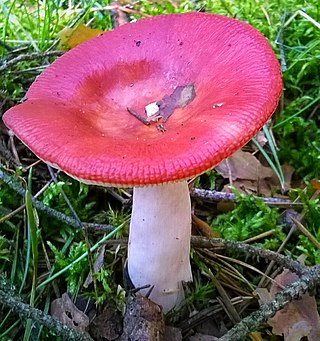
Russula emetica, commonly known as the sickener, emetic russula, or vomiting russula, is a basidiomycete mushroom, and the type species of the genus Russula. It has a red, convex to flat cap up to 8.5 cm (3.3 in) in diameter, with a cuticle that can be peeled off almost to the centre. The gills are white to pale cream, and closely spaced. A smooth white stem measures up to 10.5 cm (4.1 in) long and 2.4 cm (0.9 in) thick. First described in 1774, the mushroom has a wide distribution in the Northern Hemisphere, where it grows on the ground in damp woodlands in a mycorrhizal association with conifers, especially pine.
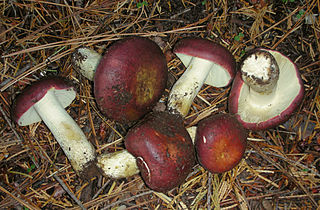
Russula xerampelina, also commonly known as the shrimp russula, crab brittlegill, or shrimp mushroom, is a basidiomycete mushroom of the brittlegill genus Russula. Two subspecies are recognised. The fruiting bodies appear in coniferous woodlands in autumn in northern Europe and North America. Their caps are coloured various shades of wine-red, purple to green. Mild tasting and edible, it is one of the most highly regarded brittlegills for the table. It is also notable for smelling of shellfish or crab when fresh.

Russula claroflava, commonly known as the yellow russula, yellow swamp russula or yellow swamp brittlegill, is a basidiomycete mushroom of the genus Russula. It is found in wet places under birch and aspen woodlands across Europe and North America. It has a yellow cap, white gills and stipe and bruises grey. It is mild-tasting and regarded as good to eat.

Russula nigricans, commonly known as the blackening brittlegill or blackening russula, is a gilled mushroom found in woodland in Europe. It gains both its common and scientific name from its propensity to turn black from cutting or bruising.
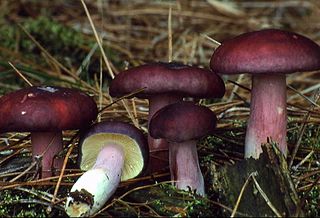
Russula sardonia, commonly known as the primrose brittlegill, is a mushroom of the genus Russula, which are commonly known as brittlegills. The fruiting body, or mushroom, is a reddish-purple, the colour of blackberry juice, and is found in coniferous woodland in summer and autumn. It is inedible, and like many inedible members of the genus, has a hot, peppery taste.

Russula sanguinaria, commonly known as the bloody brittlegill or rosey russula, is a strikingly coloured mushroom of the genus Russula, which has the common name of brittlegills. It is bright blood-red, inedible, and grows in association with coniferous trees. It was previously widely known as Russula sanguinea.
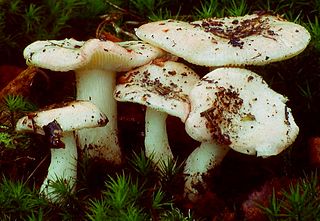
Russula betularum is a small, very pale member of the Russula (brittlegills) genus of mushrooms. It is usually white to very pale pink, inedible, and grows with birch trees. It is commonly known as the birch brittlegill.
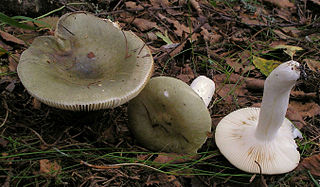
Russula aeruginea, also known as the grass-green russula, the tacky green russula, or the green russula, is an edible Russula mushroom. Widely distributed in northern temperate regions, it is usually found under birch, mostly in pine forests. The very poisonous death cap can have a similar appearance, especially from above.
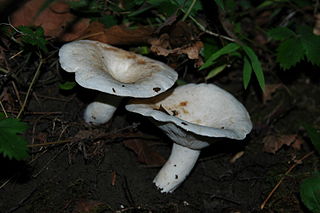
Lactifluus piperatus, commonly known as the blancaccio, is a semi-edible basidiomycete fungus of the genus Lactifluus. Despite being edible, it is not recommended by some because of its poor taste, though can be used as seasoning when dried. The fruiting body is a creamy-white mushroom which is funnel-shaped when mature, with exceptionally crowded gills. It bleeds a whitish peppery-tasting milk when cut. Widely distributed across Europe and eastern North America, Lactifluus piperatus has been accidentally introduced to Australia. Mycorrhizal, it forms a symbiotic relationship with various species of deciduous tree, including beech, and hazel, and fruiting bodies are found on the forest floor in deciduous woodland.

Russula delica is a mushroom that goes by the common name of milk-white brittlegill, and is a member of the genus Russula, all of which are collectively known as brittlegills. It is mostly white, with ochraceous or brownish cap markings, and a short robust stem. It is edible, but poor in taste, and grows in coniferous, broadleaved, or mixed woods. It can be confused with other white Russula species and certain white Lactarius species.

Lactarius rufus is a common, medium-sized member of the mushroom genus Lactarius, whose many members are commonly known as milkcaps. Known by the common name of the rufous milkcap, or the red hot milk cap in North America. It is dark brick red in color, and grows with pine or birch trees.

Lactarius glyciosmus, commonly known as the coconut scented milk cap, is a semi-edible mushroom in the genus Lactarius. Mycorrhizal, it can be found growing in soil at the base of birch trees in Europe. It is typically coloured a greyish lilac, with the sometimes hollow stem a little lighter coloured than the cap. It has crowded, decurrent gills, and smells strongly of coconuts.

Lactarius vietus is a species of fungus in the family Russulaceae, first described by Elias Magnus Fries. It produces moderately sized and brittle mushrooms, which grow on the forest floor or on rotting wood. The flattened-convex cap can vary in shape, sometimes forming the shape of a wide funnel. It is typically grey, but the colour varies. The species has crowded, light-coloured gills, which produce white milk. The spore print is typically whitish, but also varies considerably. The mushrooms typically have a strong, acrid taste and have been described as inedible, but other authors have described them as consumable after boiling. L. vietus feeds by forming an ectomycorrhizal relationship with surrounding trees, and it favours birch. It grows in autumn months and is fairly common in Europe, North America and eastern Asia.

Lactarius pallidus, the pale milkcap, is an edible mushroom of the genus Lactarius. It is pale in colour, and found on the floor in beech or birch woodland. It's smooth cap features a particularly thick layer of flesh and often has an incurved margin. Though generally considered edible, it is not recommended to be eaten raw. It is common in Europe, and less common in North America and Australasia.

The mushroom Russula fellea goes by the common name of the geranium-scented russula, or bitter russula and is a member of the genus Russula, all of which are commonly known as brittlegills. It is straw or honey coloured and in Britain grows in beech woods during autumn. It is inedible.
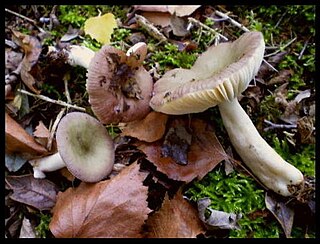
The mushroom Russula gracillima, commonly known as the slender brittlegill, is a member of the genus Russula, whose members are commonly known as brittlegills. It is a small, pale, long stemmed brittlegill associated mainly with birch and is occasional in Europe, Asia, and North America.
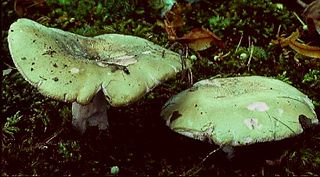
The edible wild mushroom Russula heterophylla, that has lately been given the common name of the greasy green brittlegill is placed in the genus Russula, the members of which are mostly known as brittlegills. It is a variably colored mushroom, found in deciduous forests, and woods in Britain, Europe, and Scandinavia. Appearing with broad-leaved trees in summer to early autumn, it usually has a greenish coloration.

Russula albidula is a species of mushroom in the genus Russula. The species, known in the vernacular as the boring white russula or the whitish brittlegill, is nondescript, with a small or medium dirty white fruit body, and a highly acrid taste. It is found in eastern North America.

Russula densifolia, commonly known as the crowded russula or the reddening russula, is a species of agaric fungus in the family Russulaceae. It was first described in 1833 and given its current name in 1876. A widespread species, it is found in Asia, Europe, and North America, where it fruits on the ground in mixed and deciduous forests. Fruit bodies (mushrooms) are robust and squat, with caps up to 14.5 cm (5.7 in) in diameter, and stems that are 2–7.5 cm (0.8–3.0 in) long by 1.2–2.5 cm (0.5–1.0 in) thick. The mushrooms are characterized by the red and then black color changes that occur in the flesh when it is bruised, and a relatively thick cap cuticle. Although the mushroom is sold as an edible species in some areas of Asia, it is mild to moderately toxic, and may cause gastrointestinal upset if consumed. Several bioactive compounds have been isolated and identified from the mushroom.

Russula vinosa, commonly known in English as the darkening brittlegill, is a species of basidiomycete mushroom found in coniferous woodlands in Europe and North America in summer and early autumn. Unlike many red-capped members of the russula genus, it is edible and mild-tasting. It is usually understood to have a symbiotic relationship with evergreen tree roots, except for in mountainous areas where it has occasionally associated with birches.




















